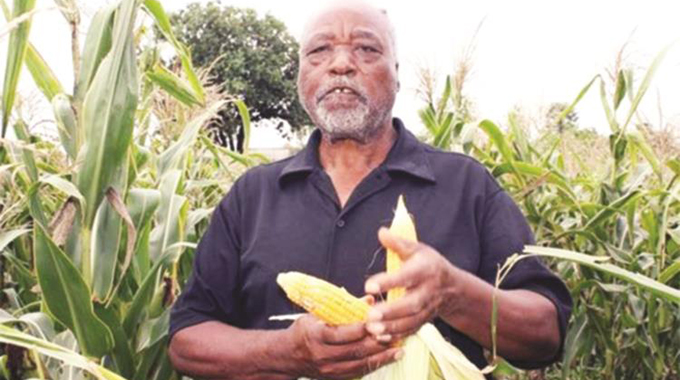Farmer combats ‘hidden hunger’. . . grows biofortified crops

Correspondent
Smallholder farmer Mr Musiyiwa Musonza (76) is triumphant as he shows a thriving vitamin A orange maize crop in his field despite high temperatures experienced in Mazowe District in Mashonaland Central Province that destroyed most plants at germination.
“This area has never been this hot. I was pleased the variety is drought-tolerant. Despite dry conditions in January, my orange maize variety was able to yield a good harvest. I’m preparing my maize field to plant it again during this year’s agricultural season,’’ says Mr Musonza.
Mr Musonza is sure of another harvest despite poor agricultural conditions being experienced across most parts of the country.
“I have now proved that the orange maize can give us a better harvest, and I will continue to grow this kind of maize because it can even help me and my family have a better life,” said Mr Musonza.
“My community likes the orange maize because it contributes to reducing the number of people with stunting due to vitamin A deficiency,’’ said Mr Musonza.
“Government and development organisations should put up awareness programmes across the country to promote its adoption and consumption because of the nutritional benefits.’’
White maize is limited in minerals and vitamins and doesn’t contain carotenoids, the orange-coloured nutrients that are the building blocks of vitamin A.
In Zimbabwe, malnutrition is prevalent among under five children as well as women of reproductive age — mostly between 15 and 49 years.
This results in serious negative health consequences contributing to lower IQ, stunting, and blindness in children.
According to the World Bank, malnourished children are more likely to drop out of school and have lower incomes as adults, and contribute to reduced overall economic growth.
Zimbabwean children under the age of five constitute 20 percent of those who have vitamin A deficiency and one out of every three children is anaemic.
Almost 33 000 children in the country are in need of urgent treatment for severe acute malnutrition, according to the United Nations Children’s Fund (UNICEF).
Also according to the Zimbabwe National Nutrition Survey conducted in 2018, 26 percent of children were experiencing stunted growth, while malnutrition was rampant across all the country’s 10 provinces.
The majority of rural households in Zimbabwe do not meet minimum dietary diversity, relying on a cereal-based diet, where meat is a rarity, says the Zimbabwe Food and Nutrition Council.
Despite stunting prevalence having declined from 33 percent in 2010, it remains above the acceptable global threshold of 20 percent.
For example, in Chimanimani District in Manicaland Province, the proportion of stunting in children was 35 percent nationally, says the 2018 Zimbabwe National Nutrition Survey.
Though Vitamin A deficiency can be addressed through consumption of a variety of nutritious foods, like yellow, orange and red pigmented fruits, dark leafy vegetables, or animal products such as milk, eggs, liver and cheese, these are often too expensive or unavailable in Zimbabwe’s rural areas, where 67 percent of the country’s 15 million people live.
Since 2015, Harvest Plus, through the Livelihoods and Food Security Programme (LFSP), has collaborated with the International Maize and Wheat Improvement Centre (CIMMYT), Department of Research and Specialist Services (DR&SS), and more than 30 national and international partners, in breeding biofortified crop varieties of vitamin A orange maize.
The LFSP is a multi-year livelihoods, food and nutrition security intervention funded by UK Aid and managed by Food and Agriculture Organisation of the United Nations and Palladium. Through the programme, biofortification has been piloted in 12 districts of Zimbabwe.
Biofortification is a nutrient-specific intervention designed to reduce micro-nutrient malnutrition.
Biofortification increases the density of vitamins and minerals in a crop through conventional plant breeding or agronomic practices.
When consumed regularly, biofortified crops generate measurable improvements in health and nutrition. The process develops crops rich in nutrients for consumers as well as the agronomic characteristics like drought and disease resistance valued by farmers.
It is considered a sustainable way to bring micro-nutrients to populations with limited access to diverse diets.
“Our focus is on hidden hunger, caused by insufficient mineral and vitamins in the diet — that is the major hunger problem Zimbabwe faces today,” says Mr Charles Mutimaamba, HarvestPlus/Zimbabwe country manager.
“But effective science can make a huge difference by enriching staple crops such as maize with vitamin A and providing smallholder farming households with nutritionally enhanced food.’’
During the 2017-2018 cropping season, 44 tonnes of vitamin A maize seed was distributed to 12 districts and about 22 000 households benefited.
During the 2018/2019 agricultural season, 20 tonnes of vitamin A maize seed was also distributed to the 12 districts and 20 000 households benefited.
By December 2018, HarvestPlus/Zimbabwe had directly reached more than 250 000 households with biofortified seeds both directly and through market-led interventions. By 2020, an anticipated 400 000 smallholder farmers will be growing biofortified crops.
“The orange maize assures me that my grandchildren get a nutritious meal and this means we don’t only rely on Government supplements,’’ said Mr Musonza.
“My family now prefers the vitamin A orange over the white maize, as it has great health benefits for my grandchildren and the taste is great!’’
To ensure long-term sustainability and competitiveness, seed companies are engaging in vitamin A orange maize seed multiplication, thereby establishing their own product lines.









Comments